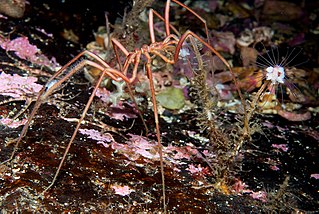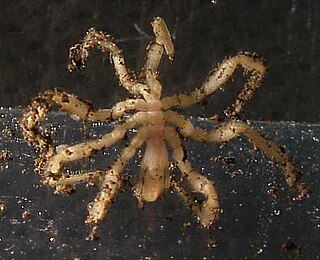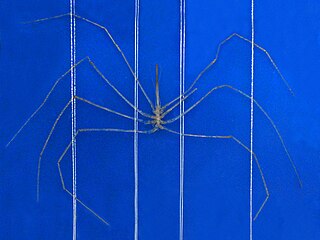
Sea spiders are marine arthropods of the order Pantopoda, belonging to the class Pycnogonida, hence they are also called pycnogonids. They are cosmopolitan, found in oceans around the world. The over 1,300 known species have leg spans ranging from 1 mm (0.04 in) to over 70 cm (2.3 ft). Most are toward the smaller end of this range in relatively shallow depths; however, they can grow to be quite large in Antarctic and deep waters.

Linyphiidae, spiders commonly known as sheet weavers, or money spiders is a family of very small spiders comprising 4706 described species in 620 genera worldwide. This makes Linyphiidae the second largest family of spiders after the Salticidae. The family is poorly understood due to their small body size and wide distribution; new genera and species are still being discovered throughout the world. The newest such genus is Himalafurca from Nepal, formally described in April 2021 by Tanasevitch. Since it is so difficult to identify such tiny spiders, there are regular changes in taxonomy as species are combined or divided.

Colossendeidae is a family of sea spiders. This family includes more than 100 species distributed among six genera. These sea spiders inhabit the deep sea mostly but are also found in shallower waters, especially in Antarctic and Arctic waters.

Hedgpethia is a genus of sea spider, in the family Colossendeidae. The genus was named after the marine biologist and sea spider specialist Joel Hedgpeth.

Nymphonidae is a family of sea spiders which has representatives in all the oceans. This family contains some 250 species, most of which are found in the genus Nymphon. Nymphonid bodies are between 1 and 15 mm long, the extent between the points of the legs reaching 150 mm. Most species are predators of hydroids. Like most sea spiders, species in this family have four pairs of legs, except for Pentanymphon antarcticum, which has five pairs, and Sexanymphon mirabilis, which has six pairs.
Cyclaspis is a genus of cumacean crustaceans in the subfamily Bodotriinae, containing the following species:

Pycnogonum is a genus of sea spiders in the family Pycnogonidae. It is the type genus of the family.

Ammotheidae is the most diversified group of the class Pycnogonida, with 297 species described in more than 20 genera, of which only Nymphopsis and Sericosura were found to be monophyletic. Despite its internal taxonomic uncertainty, studies on 18S rRNA supports its monophyly, and the subdivision on Achelinae and Ammotheinae subfamilies.

Achelia is a genus of pycnogonids in the family Ammotheidae.

Tanystylum is a genus of pycnogonids in the family Ammotheidae.

Colossendeis is a genus of sea spider belonging to the family Colossendeidae. Phylogenetic analysis based on molecular data indicates that this genus is paraphyletic with respect to the genera Decolopoda and Dodecolopoda, which are found to be nested within the genus Colossendeis in a phylogenetic tree.

Callipallene is a genus of sea spiders in the family Callipallenidae. There are more than 30 described species in Callipallene.

Phoxichilidium is a genus of sea spiders within the family Phoxichilidiidae. Members of this genus can be found in all oceans at depths up to 1074 meters.
Dodecolopoda is a monotypic genus of sea spider in the family Colossendeidae. The only species in this genus is Dodecolopoda mawsoni. This species is notable as one of only two species of sea spider with six pairs of legs and the first such species to be discovered.

Decolopoda is a genus of sea spider belonging to the family Colossendeidae. This genus includes two valid species, D. australis and D. qasimi. As the name of this genus implies, these two species are among the seven species of sea spider with five pairs of legs instead of the usual four leg pairs. The species D. australis is notable as the first polymerous sea spider to be discovered.













